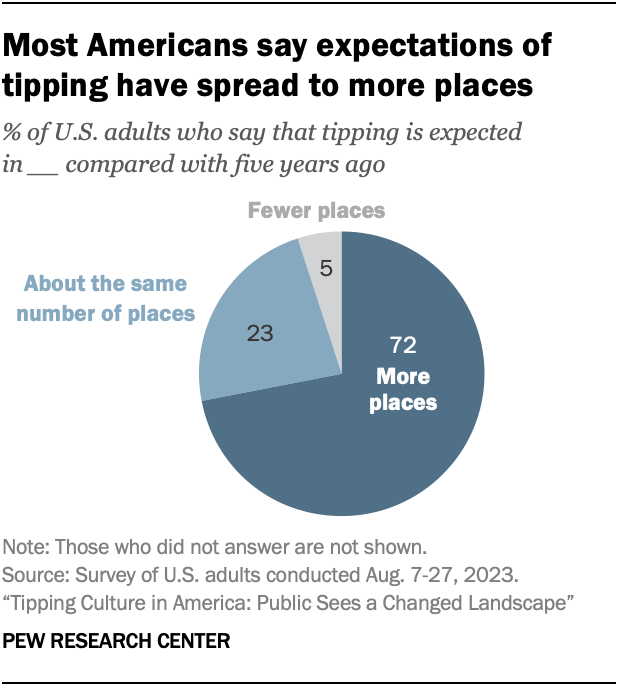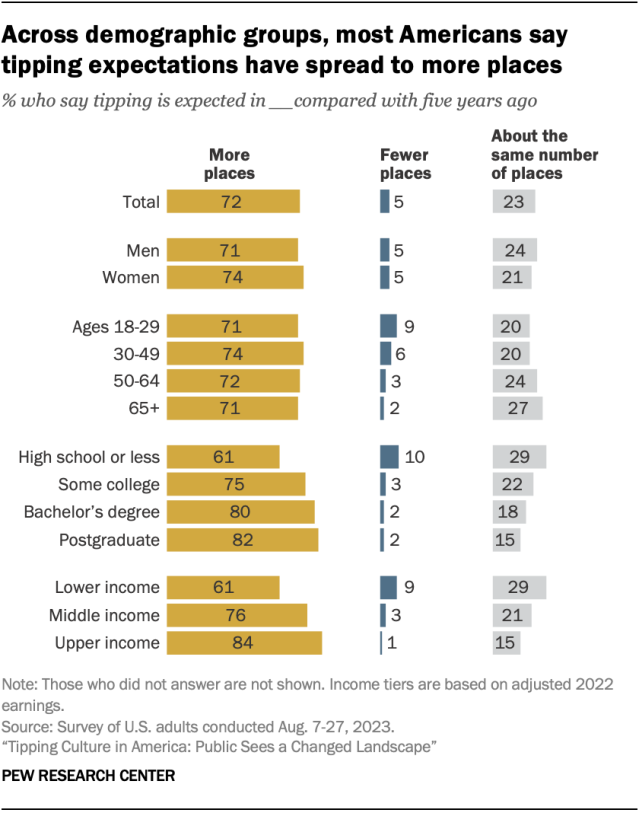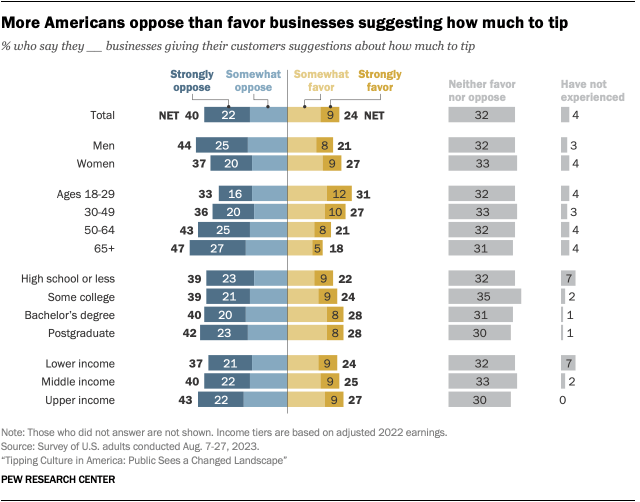A broad majority of Americans say they’re being asked to tip service workers more frequently than in the past. Around seven in ten U.S. adults (72%) say tipping is expected in more places today than it was five years ago, a finding that tracks with anecdotal reporting and has even been dubbed “tipflation.”

But even as Americans say they’re being asked to tip more often, relatively few have a great deal of confidence about when and how to do so. Only about a third say it’s extremely or very easy to know whether (34%) or how much (33%) to tip for different types of services.
Nor is there consensus on whether tipping – which is built into the pay structures and business models of many service industries – is more of a choice or an obligation for consumers. Around two-in-ten Americans (21%) say it’s more of a choice, while 29% say it’s more of an obligation. The largest share (49%) say it depends on the situation, underscoring the lack of a single set of rules or expectations.
We surveyed nearly 12,000 U.S. adults to find out how they feel about the common yet sometimes confusing custom of tipping, including whether they themselves would or wouldn’t tip in specific situations. Among our key findings:
- The public is more likely to oppose than favor suggested tip amounts. More Americans oppose (40%) than favor (24%) businesses suggesting tip amounts to their customers – for example, on the bill or on a checkout screen. Another 32% neither favor nor oppose the practice.
- Americans broadly oppose automatic service charges. About seven in ten adults (72%) say they oppose businesses including automatic service charges or tips on customers’ bills, regardless of group size – including half who strongly oppose the practice. Only 10% favor such charges.

- Americans’ tipping behaviors vary widely by situation. About nine-in-ten adults who eat at sit-down restaurants (92%) say they always or often leave a tip in this scenario. Among those using other services, smaller majorities tip when getting a haircut (78%), having food delivered (76%), buying a drink at a bar (70%), or using a taxi or rideshare service (61%). Relatively few Americans always or often tip when buying a coffee (25%) or eating at a fast-casual restaurant (12%).
- A majority of Americans say they would tip 15% or less for an average meal at a sit-down restaurant. Nearly six-in-ten (57%) say this, including 2% who say they wouldn’t leave any tip. Only a quarter of people say they’d tip 20% or more.
- For most people, tipping is first and foremost about service. Around three-quarters of adults (77%) say the quality of the service they receive is a major factor in deciding whether and how much to tip. None of the other factors we asked about comes close.
The survey comes at a time when tipping – a practice that Americans broadly embrace yet have long felt conflicted about – is undergoing significant structural and technological changes. These changes include the expansion of digital payment platforms and devices that encourage tipping and the spread of mandatory service charges.
For this report, the Pew Research Center surveyed 11,945 U.S. adults from Aug. 7 to Aug. 27, 2023, using the Center’s nationally representative American Trends Panel. The following chapters take a closer look at:
1. How Americans feel about the basics of tipping
In the United States, the practice of leaving gratuities began in the late 1800s and was well established by the Roaring Twenties (read “A brief history of tipping in the United States”). Despite this long history with tipping, Americans express ambivalence or uncertainty on a variety of questions related to it.
Is tipping more a choice or an obligation?
Take the fundamental question of whether tipping is more of a choice or an obligation, or whether it depends on the situation. Overall, 21% of U.S. adults say it’s more of a choice, 29% say it’s more of an obligation and 49% say it depends.

In nearly every demographic group, the largest share of Americans say tipping depends on the situation. But there are still some differences in the public’s views:
Younger people are likelier than older people to see tipping as more of an obligation. Some 38% of adults under 30 say it’s more of an obligation, compared with smaller shares of older Americans.
Conversely, about three-in-ten among those 65 and older (29%) see tipping as more of a choice, while roughly two-in-ten or fewer say this among younger age groups.
The sense of tipping as an obligation rises with income and education. About four in ten upper-income adults (39%) say tipping is more of an obligation, compared with 30% of middle-income people and 24% with lower incomes. Similarly, 41% of Americans with postgraduate degrees say it’s more of an obligation; smaller shares of people with lower levels of educational attainment say this.
Uncertainty over whether to tip and how much
When it comes to knowing whether or how much to tip, relatively few Americans express a great deal of confidence. About a third of U.S. adults (34%) say it’s extremely or very easy to know whether to tip for different kinds of services these days, and a similar share (33%) say the same about knowing how much to tip. Here, too, there are some key demographic differences:

People with upper incomes and those with more education are less confident about tipping than those with lower incomes or less education. For example, only about a quarter of upper-income people (25%) and those with bachelor’s degrees (26%) say it’s extremely or very easy to know whether to tip in a given situation.
Greater shares of those with upper incomes (37%) and bachelor’s degrees (35%) instead say it’s not too or not at all easy. The results were similar when we asked how easy it is to know how much to tip. (For demographic differences on this and other questions in the survey, read the Appendix.)
Men express more confidence than women about tipping. Men are modestly more likely than women to say it’s extremely or very easy to know whether to tip (37% vs. 32%) and how much to tip (37% vs. 29%).
How should tips be distributed?
Then there’s the matter of where the tips themselves should go. To assess this, we prompted Americans to think of a restaurant with wait staff who work for tips and asked how those tips should be distributed.

The balance of opinion is clear: A broad majority of Americans (72%) say the fairest way would be for each server to keep all of the money they receive in tips. Far fewer say the fairest way would be for tips to be pooled together and then shared among the entire staff (14%) or among all the servers (13%).
It’s not uncommon for restaurants to require servers (who, by the nature of their jobs, collect the most tips) to share tips with bartenders, food runners, table bussers, hosts and other workers. Such “tip pool” or “tipping out” arrangements are extensively regulated by state and federal law. Certain workers may or may not be eligible to participate, depending on how they’re paid.
2. How Americans see recent developments in tipping
The COVID-19 pandemic, subsequent labor shortages and supply chain problems, a burst of inflation and new payment technologies have upended large swaths of the service economy – including the tipped sectors. And a large majority of Americans have perceived a shift in the nation’s tipping culture in recent years.

Overall, 72% of U.S. adults say tipping is expected in more places today than it was five years ago. Only 5% say it is expected in fewer places, while 23% say it’s expected in about the same number of places. Across demographic groups, majorities say tipping is expected in more places now compared with five years ago.
Whether Americans actually are tipping more frequently is difficult to say. There’s no official data on how many U.S. businesses rely on tips to compensate their workers or what share of workers are regularly tipped.1
There is, however, a widely reported perception that more businesses are at least offering customers the opportunity to tip workers. The adoption of point-of-sale tablets, apps, and digital kiosks has made it easier for businesses to provide customers with tip prompts and suggestions.
The public is more negative than positive about such automated tip suggestions, whether listed on a bill or shown on a screen when checking out. Four in ten U.S. adults strongly or somewhat oppose suggested tips, while 24% strongly or somewhat favor them and 32% neither oppose nor favor them. Attitudes differ somewhat by age and gender:
- Older Americans tend to feel most negatively about tip suggestions. Nearly half of people ages 65 and older (47%) strongly or somewhat oppose them. Adults under 30 are more split in their views: Roughly equal shares say they favor tip suggestions (31%), oppose them (33%), or neither favor nor oppose them (32%).
- Men are more likely than women to oppose suggested tip amounts: 44% of men strongly or somewhat oppose them, compared with 37% of women.

Feelings are much more negative when it comes to businesses – mostly restaurants – adding fixed-rate service charges to customers’ bills. Overall, 72% of U.S. adults strongly or somewhat oppose businesses including an automatic service charge or tip on the bill, while only 10% strongly or somewhat favor this. Another 13% neither oppose nor favor it.
Across demographic groups, majorities of Americans say they oppose automatic service charges or tips on customers’ bills. But there are again some differences by age and income:
- Older adults are more likely than younger Americans to oppose automatic service charges or tips. About eight-in-ten (79%) of those ages 65 and older oppose such charges, compared with six-in-ten adults under 30.
- People with lower incomes are somewhat less likely than those with higher incomes to oppose automatic service charges or tips. Still, 66% of lower-income adults oppose such charges.

3. Services Americans do and don’t tip for – and how much
The largest share of Americans (49%) say the decision about whether to tip or not depends on the situation. To explore this sentiment further, we asked Americans whether they’d leave a tip in seven specific scenarios that are common in daily life.

Americans report tipping at sit-down restaurants more regularly than in any other scenario we asked about. Some 92% of U.S. adults who dine at sit-down restaurants – that is, ones where a server takes their order – say they always or often tip in this situation. That includes 81% who say they always tip in this situation.
Roughly eight in ten Americans who get haircuts (78%) say they always or often tip when doing so. A similar share of Americans who have food delivered (76%) report always or often tipping in this situation.
Seven-in-ten U.S. adults who buy drinks at bars say they always or often leave a tip when doing so. And about six in ten adults who use taxi or rideshare services (61%) always or often leave a tip.
Tipping is much less common in the two other scenarios we asked about. Only a quarter of Americans who buy coffee or other beverages at a coffee shop say they always or often tip in this situation. And just 12% of those who dine at fast-casual restaurants – that is, restaurants where there are no servers – always or often leave a tip.
The public’s tipping habits, among those who use each service, vary somewhat by demographic group:
- In most scenarios, upper-income Americans are more likely than those with middle or lower incomes to tip always or often. An exception: Respondents with lower incomes are most likely to report tipping at fast-casual restaurants. Even so, only 16% say they always or often do this.
- Americans with at least a bachelor’s degree are more likely to say they always or often tip in nearly all scenarios asked about. But similar shares of those with and without college degrees say they usually tip at coffee shops and fast casual restaurants.
How much do people tip for a sit-down meal?

Since a large majority of Americans say they usually tip when eating at a sit-down restaurant, we also wanted to know how much of a tip they’d leave. So, we gave our respondents a hypothetical scenario in which they went to a restaurant and had average – but not exceptional – food and service.
In this situation, a majority of Americans (57%) say they would tip 15% or less, including 2% who wouldn’t leave a tip at all. Another 12% of adults say they would leave a tip of 18%, while a quarter say they would tip 20% or more.
Tip amounts vary by income, age, and other factors:
- Americans with upper incomes tend to tip more. Upper-income adults are more likely than middle- and lower-income adults to tip 18% or 20% for an average dining experience at a sit-down restaurant. Conversely, those with middle or lower incomes are more likely than upper-income adults to tip 15% or less in this situation.
- Older Americans are slightly more likely than younger adults to tip 15% or less. Among those 65 and older, 61% would leave a tip of 15% or less. That compares with 54% of adults under 30.

